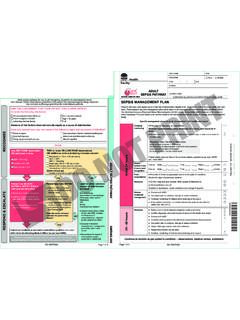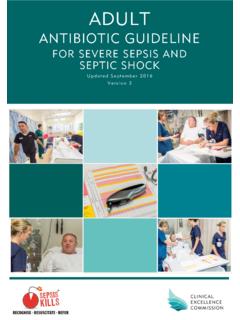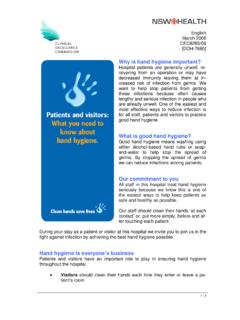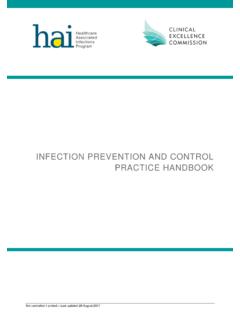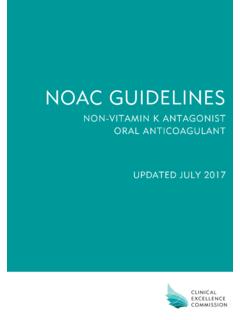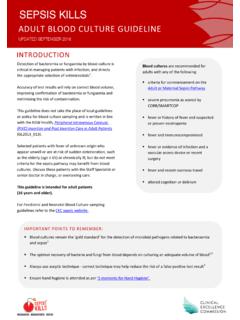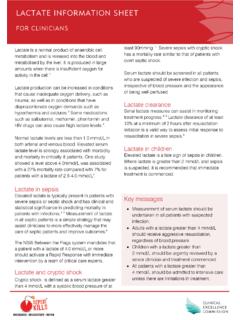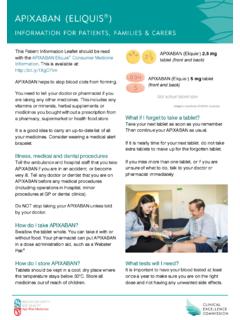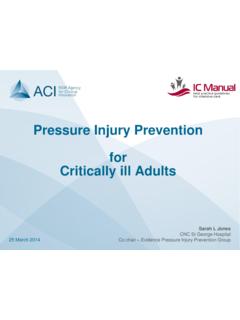Transcription of SAMPLE TERMS OF REFERENCE - Ministry of Health
1 SAMPLE TERMS OF REFERENCE FOR ANTIMICROBIAL stewardship COMMITTEES Background As a patient safety and clinical quality initiative, an antimicrobial stewardship (AMS) program requires appropriate oversight and The involvement of key players, such as executives, medical leaders, nursing leaders, pharmacy and microbiology staff, is essential in planning and implementing an effective antimicrobial stewardship Antimicrobial stewardship committees are a way to bring together these key people, and involve them in decision making for the AMS program from planning through to delivery of program initiatives. TERMS of REFERENCE (TOR) for the AMS committee are a means of describing the roles and responsibilities of members, and the shared goals of the committee. TERMS of REFERENCE documents can be useful to demonstrate governance arrangements in place for AMS within a facility or local Health district (LHD), clarify and consolidate the expectations of committee members, and ensure the committee is action-orientated.
2 Purpose of this document The purpose of this document is to provide staff in NSW local Health districts and specialty Health networks with a SAMPLE TOR document for their AMS committee. The content of this SAMPLE TOR is based on similar documents used in NSW public Health facilities and may be a useful starting point for local TOR development. It should be noted that not all NSW public Health facilities need a dedicated AMS Committee. In some facilities, oversight of the AMS program may be provided by a Drug and Therapeutics Committee, or a Quality and Safety Committee. This is a local decision that should take place in liaison with the LHD clinical governance unit. This document should be read in conjunction with the AMS Teams and Committees Fact Sheet, available on the QUAH website. For further information and advice, please contact the CEC: What to include in an AMS Committee TERMS of REFERENCE Before starting to draft your AMS Committee TOR, ask your LHD/facility executive if there is a standard template for all committee TOR that needs to be used.
3 Such templates can provide helpful advice on reporting structures, such as whether minutes of the AMS committee need to be sent to an overarching quality committee. The template may also include information on confidentiality of committee documents, expectations around key performance indicators for committees, and how much detail is required in each section. The following are headings included on some TOR: Functions of committee why has the committee been set up? Responsibilities and activities of the committee what will the committee do? Organisational risks addressed by this committee how does the committee address safety and quality risks? Membership of committee who will be on the committee? Which departments or services do these members represent? Roles of members chair, secretary which members are responsible for specific functions? Quorum how many members are needed for the committee meeting to go ahead?
4 How many members are required to be present for decision making? Frequency and length of committee meetings how often will meetings be held, and how long will they last? Agenda preparation and minutes circulation who will prepare the agenda and minutes, and when will these be circulated to members? Reporting lines does this committee report to another committee? What are the links between this committee and the Drug and Therapeutics Committee, Infection Prevention and Control Committee, and the clinical governance unit? Evaluation/Key Performance Indicators how will the effectiveness of the committee be assessed or measured? Review of the TERMS of REFERENCE how often will these TERMS of REFERENCE be reviewed and updated if needed? REFERENCE : M, Cruickshank M (eds). 2010. Antimicrobial stewardship in Australian hospitals. Australian Commission on Safety and Quality in Healthcare: Sydney SAMPLE TERMS of REFERENCE for Antimicrobial stewardship Committees A component of the QUAH Antimicrobial stewardship Toolkit Revised April 2017 Clinical Excellence Commission 2017 SHPN (CEC) 170178 SAMPLE TERMS OF REFERENCE TERMS OF REFERENCE XX hospital ANTIMICROBIAL stewardship COMMITTEE 1.
5 Function The XX hospital Antimicrobial stewardship (AMS) Committee will provide oversight and input into the development, implementation and ongoing review of the AMS program at XX hospital . The AMS program will involve a systematic approach to optimising the use of antimicrobials in XX hospital in order to improve patient outcomes, reduce inappropriate antimicrobial use, and reduce adverse consequences of antimicrobial use (including antimicrobial resistance, toxicity and unnecessary costs).1 2. Responsibilities and Activities The XX hospital AMS Committee will provide high level advice and decision making with regards to the overall approach to optimising antimicrobial use, and specific strategies to improve antimicrobial prescribing in XX hospital . These strategies include, but are not limited to: The use of clinical guidelines consistent with the latest version of Therapeutic Guidelines: Antibiotic, taking into account local microbiology and antimicrobial susceptibility patterns; The use of formulary restriction and approval systems for broad-spectrum and newer generation antimicrobials to limit use to patients in whom their use is clinically justified; Review of antimicrobial prescribing with intervention and direct feedback to the prescriber; Systems to monitor antimicrobial usage and resistance, such as provision of antimicrobial usage reports and other indicators of performance for the AMS program; The use of selective reporting of susceptibility testing results by the clinical microbiology service, consistent with the antimicrobial formulary and guidelines.
6 Education of prescribers, pharmacists and nurses about good antimicrobial prescribing practice and antimicrobial resistance; The use of point-of-care interventions, including streamlining or de-escalation of therapy, dose optimisation or parenteral-to-oral These strategies are consistent with the recommendations of the Australian Commission on Safety and Quality in Healthcare and the Clinical Excellence Commission. These strategies will support the requirements of the National Safety and Quality Health Service Standards, specifically antimicrobial stewardship actions. 1 Duguid M, Cruickshank M (eds). 2010. Antimicrobial stewardship in Australian hospitals. Australian Commission on Safety and Quality in Healthcare: Sydney. SAMPLE TERMS OF REFERENCE The core activities of this committee include: To review, endorse and plan implementation of clinical guidelines for antimicrobial prescribing; To develop, endorse and plan implementation of the restriction of selected antimicrobial agents in liaison with the XX hospital Drug and Therapeutics Committee; To develop, endorse and plan implementation of systems to review antimicrobial prescribing and feedback results to prescribers; To develop, endorse and plan implementation of systems to monitor antimicrobial usage and resistance; To liaise with clinical microbiology services in XX hospital to ensure selective reporting of susceptibility testing results is in place and aligns with the antimicrobial formulary and guidelines.
7 To review, endorse and plan implementation of an education program for good antimicrobial prescribing practice and antimicrobial resistance, in liaison with clinical educators in XX hospital ; To develop, endorse and plan implementation of resources to support point-of-care interventions; To monitor the effectiveness of strategies used in the AMS program at XX hospital , including the review of relevant reports and key performance indicators; To risk assess and plan action to improve the effectiveness of the AMS program at XX hospital . 3. Organisational Risks Addressed by this Committee The key risks to the organisation that will be managed by this Committee include: Risks associated with inappropriate use of antimicrobials (including antimicrobial resistance, toxicity and unnecessary costs); Conflict that may arise from formulary restrictions and/or performance measures based on concordance with clinical guidelines.
8 Antimicrobial stewardship is a key strategy in the prevention and management of healthcare associated infections (HAI). The XX hospital AMS Committee will report to the XX hospital Infection Prevention Control Committee to facilitate the oversight of HAI risks that are linked to antimicrobial use, Clostridium difficile infections. SAMPLE TERMS OF REFERENCE 4. Membership and roles All members are expected to play an active role in the development, implementation and review of AMS strategies at XX hospital . Members represent their unit, department or discipline, and as such, may liaise with staff in their unit when broad input is needed development of a protocol for a specific infectious condition. Members are also expected to champion the AMS program in their own unit, and demonstrate leadership for AMS in their areas of practice as well as in their knowledge and attitudes. Membership of the AMS committee will consist of: Director Clinical Governance or General Manager (Executive Sponsor/Chair) Director Medical Services (Deputy Chair) Infectious diseases physician and/or clinical microbiologist (AMS lead) AMS Pharmacist (Secretary) Patient Safety and Clinical Quality Manager Nursing representatives <insert relevant position/s> Pharmacy representatives <insert relevant position/s> Medical staff representatives (Respiratory, Haematology, Emergency, Surgery, Critical Care, General Practitioner) Pathology representatives (Microbiology) IT representatives ( eMeds analyst) Consumer representative XX hospital Drug and Therapeutics Committee representative XX hospital Infection Prevention Control Committee representative XX hospital Medication Safety Committee representative2.
9 Other personnel may be co-opted as required to assist the work of the Committee. 5. Quorum A quorum, consisting of half the number of member plus one, must be in attendance for decision-making. 2 Center for Disease Control and Prevention, Core Elements of hospital Antibiotic stewardship Programs (accessed 7/02/2017) SAMPLE TERMS OF REFERENCE 6. Frequency of Meeting The meetings will be held monthly, on the <insert> of the month. The meetings will be set at the beginning of each calendar year and circulated to members. 7. Agenda Preparation and Minutes Circulation Papers for the committee will be prepared by the XX hospital AMS Committee Secretary and circulated one week prior to the meeting date. The agenda will be determined by the XX hospital AMS Committee Chair prior to meetings. Agenda items must be forwarded to the XX hospital AMS Committee Secretary at least one week prior to circulation of the agenda, two weeks before the next meeting.
10 Minutes will be distributed to members within two weeks of the meeting date by the XX hospital AMS Committee Secretary. In addition to committee members, minutes will be made available to: XX hospital Drug and Therapeutics Committee XX hospital Infection Prevention Control Committee XX hospital Medication Safety Committee XX hospital Quality Committee. 8. Confidentiality Matters discussed at AMS Committee meetings may be of a confidential nature and must be treated as such by members. Committee materials, proposals, business cases and procurement decisions that come into a committee member s possession must only be used or disclosed for the purpose of the AMS Committee function. To protect confidentiality, individual members must destroy all proposals or information (electronic or paper form) provided in a secure way once the purposes for which it was provided have been fulfilled. 9. Reporting Lines The Minutes of the committee will be forwarded through the XX hospital Drug and Therapeutics Committee to XX hospital Health Care Quality Committee.
